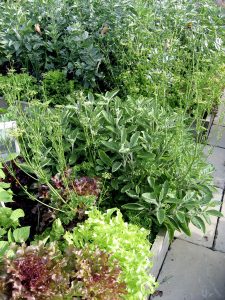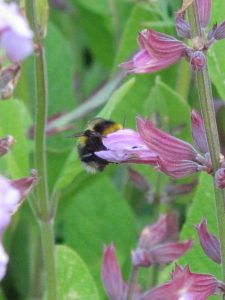If there’s one thing a Hartley Greenhouse allows you to do, it’s to go forth and propagate! And in these financially stressful times, that’s a boon because you’ll be able to create your own bit of Mediterranean magic, by raising aromatic plants from cuttings. And you’ll be able to pick your own fresh herbs, from plot to plate in seconds. It will all help the family budget and, even better, you can do all this in an unheated greenhouse.
The herb that keeps on giving is French tarragon, Artemisia dracunculus. There are two plants in my unheated greenhouse and they’ve been there for years and years. They come through cold spells because the roots are kept bone-dry in winter. Many plants will happily survive cold periods of weather as long as the roots are kept dry, because it’s winter wet that kills plants rather than cold temperatures. Potted agapanthus will also survive in an unheated greenhouse, as long as you ease off the watering from mid-September. Resume watering your tarragon and your agapanthus pots once spring arrives.
My French tarragon plants are cut back two or three times a year during summer and the stems are dried in very low oven for 30 minutes or so. The still-green foliage is removed from the stalks, cooled and then stored in half-size jam jars. It keeps for at least 12 months and these herb-filled jam jars make good homemade give-aways. One large plant will fill several jars and you can cut it back two or three times.
It’s the best herb for chicken, because it imparts an almost nutty flavour to the meat. We often follow Delia Smith’s advice ‘to roast a chicken on a plain, dull old grey day’ and there’s always a sprinkle of tarragon and a knob of butter on the top before it goes into the oven. It must be French tarragon though. Don’t confuse this aromatic delicacy with the not-so-flavourful Russian tarragon – which is useless in cooking.
French tarragon arrived in here in the 16th century, during Henry VIII’s reign. Jekka McVicar, writing in Jekka’s Complete Herb Book, tells us that Henry divorced his first wife, Catherine of Aragon, for her ‘reckless use of tarragon’ A feeble excuse, as history proved, and a fitting illustration of the old adage ‘better the devil you know’. Just look what happened afterwards. You can never have too much French tarragon your majesty, but you can have too many wives.

You can sow tarragon seeds, but buying a plant or two is the best option. The foliage should be a pale silvery green. Russian tarragon has greener leaves. Once you’ve planted it, it’s easy to propagate more. Just remove some the outer running roots in spring, or take cuttings in summer. Taking cuttings is often made out to be a ‘right faff’ to use a northern expression. However, I have an easy fail-safe method that involves using small rigid seed trays full of coarse horticultural sand. It must be coarse sand, with bits of grit included, because finer, dust-like horticultural sand dries out too easily.
Fill your trays with sand and water them well. Place them in a cool, shady part of the greenhouse, so they are available when needed. These filled sand-trays can be used for pelargoniums, plectranthus, pinks, salvias, penstemons and just about any cutting you’ve got – from fuchsia to penstemon. Every time you hear that sickening snap in the garden, you can turn most things into a cutting without the bother of having to fill up a pot and mix some compost.
Suitable cutting material should be semi-ripe, which means that the cutting is pliable but firm. With an almost rubbery feel. Very soft material doesn’t root: it tends to rot instead. Woody material is difficult, unless you can pull a cutting away and create a heel. This exposes the cambium cell layer and hormones called auxins pass through the phloem and help rooting.
General advice includes trying to take several cuttings about three inches in length. Always remove the lower leaves and any flower buds. Most things are cut beneath a leaf node, where the leaves join the stem. Clematis are an exception. They are cut between the nodes. Make a hole in the damp sand and plunge the cutting in, submerging at least half of it. Firm in lightly and keep the tray just moist, but not wet.
Once there are roots, it’s time to pot them up. A tug will tell if they’re ready. A mixture of 50% John Innes compost, 25% perlite and 25% grit works well for me. Perlite improves aeration and water drainage, warming the compost up in the process. The similar-looking vermiculite holds water, so it’s good for moisture-loving plants such as trilliums – but not so great for cuttings.
If you’re doing tender plants, such as pelargoniums, pot them up in the middle of February as long as you’ve got some greenhouse heat. If not, move the sand trays into a warmer spot (perhaps a windowsill indoors) and pot them up in late spring. Fleece on cold nights.
Basil plants can also be persuaded to overwinter in most years, but they are also easily raised from seeds sown in late spring. Use 9cm pots, because basil is a tap-rooted plant so it hates to be in a shallow seed tray. The seeds need considerable warmth to germinate, both day and night, because basil is native to the Middle East and India. These are hot spots. Late April is often a good time. You will also need to water in the mornings, because wet roots and cool night temperatures kill more basil plants off than anything else.
Basil is thought to mean the kingly herb, from the Greek word basilikon, and it certainly makes a tomato salad a royal event. It’s another must-have for the summer greenhouse and you can plant pots from the supermarket once temperatures rise. It’s impossible to take basil cuttings, but good basil plants will give you plenty of pickable leaves right up until late autumn. Shear them back, if they get too leggy.
French tarragon and basil are planted under glass in my garden, but the sunny south-facing border in front of my greenhouse is devoted to culinary Mediterranean herbs, principally sage and thyme. These can be picked through the year and thyme is extremely good with beef stews and casseroles. Sage gets used mainly in savoury stuffing, an essential with pork in our house.

Both of these aromatic subshrubs produce highly concentrated nectar so they draw in the bees come summer. If you’re growing tomatoes in your greenhouse, they’ll help to lure in the bumblebees. Members of the solanum family, including peppers aubergines, can only be pollinated by bumblebees.
I often think that culinary sage is far too good for the kitchen garden, because it’s so decorative. The most handsome of all is a large-leaved sage, Salvia officinalis ‘Berrgarten’, available from Beth Chatto. This produces much larger, soft-blue flowers than the others. The enormous leaves are also very useful in the kitchen. We have a Jamie Oliver recipe for squash soup and the first step involves frying some sage leaves in oil, so that you get that depth of flavour. It’s quite possible to make your own flavoured olive oil with herbs, whether it’s basil, thyme, tarragon or sage. Another home-made give-away that might save some money.
The dusky damson leaves of ‘Purpurascens’, the green and cream ‘Icterine’ and the silver-leaved culinary sage can all be found in garden centres. ‘Tricolor’ has three-way foliage coloured in pink-purple, sage-green and off-white. Although it’s extremely attractive, it’s not as hardy as the others in my opinion. Interplant the sages with low-growing common thymes, Thymus vulgaris, and you’ve created a kitchen cabinet of flavour.



